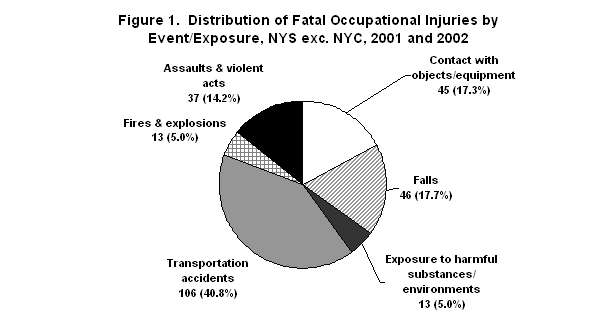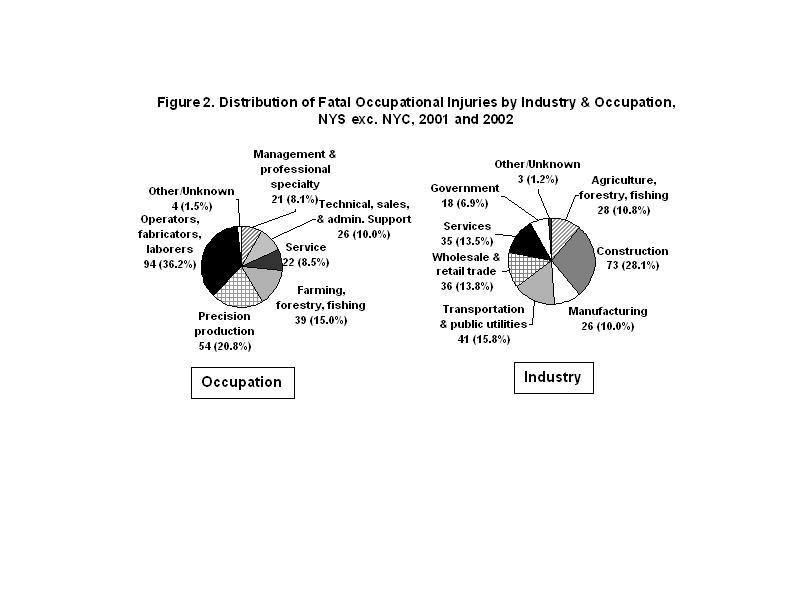Occupational Fatalities in New York - 2001 and 2002 Update
Occupational Fatalities in New York1
From 2001 through 2002, there were 260 traumatic work-related deaths reported in New York State, excluding New York City1. These largely preventable fatalities represent enormous emotional and financial costs to both families and society. Information on fatal occupational injuries is collected by the New York State Department of Health (NYSDOH) through the Census of Fatal Occupational Injuries (CFOI) program, in cooperation with the US Department of Labor Bureau of Labor Statistics (BLS), and the NYSDOH Fatality Assessment and Control Evaluation (NY FACE) program, in cooperation with the National Institute for Occupational Safety and Health (NIOSH). The purpose of these programs is to identify factors that contribute to occupational fatalities to facilitate the development of effective traumatic injury prevention/ intervention strategies.
This update provides an overview of fatal occupational injury events in New York State (excluding New York City) for the years 2001 and 2002. Information is presented on employee status, sex, age, and race; event/exposure; and industry and occupation. Synopses of NY FACE reports are also included.
Fatal Occupational Injuries, 2001 and 2002
- More than 95% of all occupational fatalities involved men.
- While wage and salary workers represent the largest percentage of occupational fatalities (76.9%), 18.8% of fatally injured workers were self-employed or working in a family business.
- The largest number of deaths occrred among those aged 35-44 (63 fatalities or 24.2%); however, a large number of fatally injured workers were age 55 and over (58 fatalities or 22.3%). Ten workers under age 20 were also killed during the two-year period.
- Approximately 83% of occupational fatalities were among Whites. Fatal injuries to Hispanic/Latino workers comprised the next largest percentage with 9.2% of the occupational fatalities recorded over the two-year period.
- Transportation accidents accounted for the largest percentage of occupational fatalities, with 40.8% of deaths occurring as a result of this event.
- The largest percentage of fatalities occurred in the construction industry (28.1%) and the transportation and public utilities industries (15.8%).
- Operator, fabricator, and laborer occupations represent the largest percentage of total fatalities (36.2%) followed by those working in precision producation occupations (20.8%).
Demographics
| N (%) | |
|---|---|
| Total | 260 (100) |
| Employee Status Wage & salary workers Self-employed/family business2 Volunteer Other/Unknown |
200 (76.9) 49 (18.8) 7 (2.7) 4 (1.5) |
| Sex Male Female |
249 (95.8) 11 (4.2) |
| Age <20 20-24 25-34 35-44 45-54 55-64 65-74 75+ Unknown |
10 (3.8) 19 (7.3) 54 (20.8) 63 (24.2) 53 (20.4) 36 (13.8) 15 (5.8) 7 (2.7) 3 (1.2) |
| Race White Hispanic/Latino Black Asian Other/Unknown |
215 (82.7) 24 (9.2) 10 (3.8) 6 (2.3) 5 (1.9) |
As shown in Table 1, fatal injuries to wage and salary workers accounted for the largest number of occupational deaths (200 fatalities, 76.9%) in New York State (excluding New York City) in 2001 and 2002. The self-employed and those working in family businesses accounted for the next largest number with 49 fatalities (18.8%); nearly one-third (30.6%) of these individuals were working in the agriculture industry.
The vast majority of occupational fatalities involved males (95.8%). Of the 11 women killed on the job in 2001 and 2002, eight (72.7%) were killed in transportation accidents; the remaining 3 women were killed as a result of assaults and violent acts.3
Although the largest number of fatally injured workers were in the 35-44-year-old age category (63 fatalities, 24.2%), a substantial number of workers were "older" workers, those age 55 and over (58 fatalities, 22.3%). Ten workers under age 20 (3.8%) were also killed during the two-year period.
Fatal injuries to White workers accounted for the majority of traumatic occupational fatalities in New York State (excluding New York City) with 215 fatalities, or 82.7%. Fatal injuries to Hispanic/Latino4 workers comprised the next largest percentage with 9.2% of the occupational fatalities reported although Hispanic workers represent only 5.1%4 of the working population in New York State (excluding New York City).
Event/Exposure
As for the period 1992-20006, transportation accidents continue to lead all other events, accounting for 40.8% of traumatic occupational fatalities (Figure 1). Slightly under half (44.3%) of these accidents occurred to workers in operator, fabricator, and laborer occupations7 such as machine operators, truck drivers, and construction laborers. Truck drivers represented the largest category of workers who were fatally injured in transportation accidents with 24 fatalities over the two-year period.
A 35-year-old truck driver died as a result of being run over by a landfill compactor at a municipal landfill. The victim worked for a municipal solid waste (MSW) trucking company and was delivering a load of refuse to the landfill. He exited the cab of his truck at the unloading site and was struck by a compactor that was backing up. The backup alarm on the compactor was working properly and the operator stated that he looked through both the rear and side mirrors before he bagan backing up but did not see the victim in his path.
In order to help prevent similar incidents from occurring in the future, NY FACE recommended that employers develop a traffic control plan to coordinate the movements of personnel and equipment, enforce a policy requiring truck drivers to remain in truck cabs during unloading, consider using additional safety devices on landfill equipment, and require all landfill personnel and visitor to wear high-visibility safety vests. (NY FACE Report 02NY007, NY FACE FACTS 02NY007)
In addition to highway vehicles, transportation accidents related to tractors played a large role in New York State occupational fatalities over the two-year period. In 2001 and 2002, ten workers were fatally injured in transportation-related tractor accidents. Half of these individuals were over age 60.
A 72-year-old part-time farmer died as a result of a tractor overturn. The victim had been brush-hogging the outer edge of a pasture when the tractor was driven onto an embankment that gave way, causing the tractor to roll over.
In order to help prevent similar incidents from occurring in the future, NY FACE recommended that all tractors be equipped with rollover protective structures (ROPS) and seatbelts, that terrain be evaluated prior to beginning tractor operations and hidden hazards marked for visibility, and that workers are provided with age appropriate tasks. (NY FACE Report 02NY023)
Occupation & Industry
As shown in Figure 2, operator, fabricator, and laborer occupations7 represent the largest percentage of total fatalities (36.2%) followed by those working in precision production occupations (20.8%). While accidents involving vehicles (60 fatalities or 40.5%) and structures and surfaces (41 fatalities or 27.7%) accounted for a large number of these fatalities, seventeen (11.5%) of the fatalities in these two occupational categories involved machinery.
A 54-year-old food production worker died after suffering a deep cut to his neck from a steel blade on a dough machine. The victim and co-worker were assigned to clean the dough machine. The victim turned off the machine and locked the main power switch, but missed setting one of the three blade control switches to its lockout position. As the victim was cleaning a hopper above the blade, the co-workers asked him for his key to unlock the main power switch of the dough machine. The victim handed the key to the co-worker who turned on the machine. This caused the dough blade to go through its automatic cutting cylce, fatally injuring the victim.
In order to help prevent similar incidents from occurring in the future, NY FACE recommended that employers provide employee training to ensure workers understand lockout/tagout programs, conduct periodic inspections to ensure lockout/tagout procedures are followed, modify cleaning procedures to avoid placing workers' bodies into points of operation, and install interlocks to eliminate possible human errors during machine maintenance and sanitation. (NY FACE Report 02NY096)
The construction industry led all industries in fatal work-related injuries, accounting for 28.1% of fatalities, although only 5.8%5 of workers in New York, excluding New York City, were employed in this industry during this two-year period. The vast majority of workers fatally injured in the construction industry worked in precision production occupations (54.8%) and operator, fabricator, and laborer occupations7 (41.1%). Another 15.8% of occupational fatalities occurred to those working in transportation and public utilities industries, with 6.9%5 of the workforce in New York, excluding New York City, working in these industries.
The agricultural industry plays a major role in the economy of upstate New York. Although only 1.7%5 of upstate New York workers were employed in agriculture, forestry and fishing industries, 10.8% of fatalities occurred in this industry. These fatally injured workers were employed in farming, groundskeeping, and forestry and logging occupations.
A 41-year-old feed mill workers died from asphyxiation as a result of entrapment and submersion in flaked corn. The victim entered the grain bin, apparently to level the corn, when a subterranean bridged pocket gave way causing the victim to become entrapped in the flowing corn.
In order to prevent similar incidents from occurring in the future, NY FACE recommended that employers develop a comprehensive safety program that documents procedures for safe entry into confined spaces, evaluate grain bins for retrofitting with mechanical fill level devices, and post signs at grain bin entrances warning of dangers and safety requirements. (NY FACE Report 02NY012)
A 48-year-old dairy farmer died after being crushed by a cow. The victim and two other workers were attempting to load cows onto a trailer using a chute created by fencing and some portable gates. One of the cows turned and attempted to push through the gate while the victim was standing by the side wall at the open end of the gate.
In order to help prevent similar incidents from occurring in the future, NY FACE recommended that cattle handling facilities be equipped with properly constructed animal loading structures; workers avoid positioning themselves in areas of entrapment when working with large animals; dangerous animals be promptly removed from farms, and work areas be modified to eliminate hazardous protrusions (NY FACE Report 03NY040)
A 36-year-old logger died as a result of being crushed by a fallen oak tree. The victim had been working by himself in a remote area felling trees when the tree he was felling struck another tree that horizontally crossed a standing tree. As the falling tree hit the crossed tree, the butt of the falling tree was thrown up into the air, striking and crushing the logger.
In order to help prevent similar incidents from occurring in the future, NY FACE recommended that loggers use proper notching techniques when felling trees, fell trees in area clear of hazards, and work in teams when felling trees. (NY FACE Report 02NY013)
Further information about the New York State Department of Health CFOI and FACE programs, as well as complete NY FACE reports, can be obtained on-line at: CFOI and NY FACE
If you know of a work-related death, you should report it to the New York State Department of Health at: 1-866-807-2130 (toll free)
New York State Department of HealthBureau of Occupational Health and Injury Prevention
Empire State Plaza-Corning Tower, Room 1336
Albany, New York 12237
_____________________________
1 New York State data does not include New York City fatalities. New York City collects and analyzes data separately.
2 Includes paid and unpaid family workers, and may include owners of incorporated businesses or members of partnerships.
3 Includes assaults and violent acts by persons (homicides); self-inflicted injury; and assaults by animals.
4 All Hispanic workers are listed under "Hispanic/Latino" and are not counted in any other race category.
5 Data derived by author from Current Population Survey using DataFerrett (dataferrett.census.gov), June 2004
6 NYS Census of Fatal Occupational Injuries
7 Includes machine operators, assemblers, and inspectors; transportation and material moving occupations; handlers, equipment cleaners, helpers and laborers.

